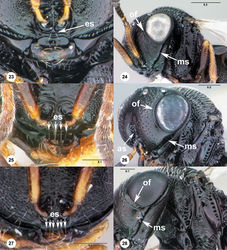Trissolcus japonicus\according to Talamas et al 2015
| Notice: | This page is derived from the original publication listed below, whose author(s) should always be credited. Further contributors may edit and improve the content of this page and, consequently, need to be credited as well (see page history). Any assessment of factual correctness requires a careful review of the original article as well as of subsequent contributions.
If you are uncertain whether your planned contribution is correct or not, we suggest that you use the associated discussion page instead of editing the page directly. This page should be cited as follows (rationale):
Citation formats to copy and paste
BibTeX: @article{Talamas2015JournalofHymenopteraResearch, RIS/ Endnote: TY - JOUR Wikipedia/ Citizendium: <ref name="Talamas2015Journal of Hymenoptera Research">{{Citation See also the citation download page at the journal. |
Ordo: Hymenoptera
Familia: Scelionidae
Genus: Trissolcus
Name
Trissolcus japonicus (Ashmead) – Wikispecies link – Pensoft Profile
- Dissolcus japonicus Ashmead, 1904: 73 (original description); Kieffer 1926[1]: 124, 125 (description, keyed).
- Trissolcus japonicus (Ashmead): Masner and Muesebeck 1968[2]: 72 (type information, generic transfer); Hirashima and Yamagishi 1981[3]: 153 (description, synonymy); Ryu and Hirashima 1984[4]: 37, 43 (description, keyed); Talamas, Buffington and Hoelmer 2013[5]: 114 (description, synonymy, type information).
- Trissolcus halyomorphae Yang: Qiu, Yang and Tao 2007[6]: 62 (unavailable: nomen nudum); Yang, Yao, Qiu and Li 2009[7]: 40 (original description); Talamas, Buffington and Hoelmer 2013[5]: 114 (junior synonym of Trissolcus japonicus (Ashmead)).
Diagnosis
As previous authors have stated (Yang et al. 2009[7]), Trissolcus japonicus belongs to the flavipes species group, first recognized by Kozlov and Lê (1976)[8] and refined by Johnson (1984)[9]. Trissolcus japonicus may be separated from other species of the flavipes group Trissolcus in the Nearctic by the following characters: orbital furrow expanded near intersection with malar sulcus; postacetabular and mesopleural epicoxal sulci formed by lines of closed cells (Fig. 70); episternal foveae extending from dorsal apex of postacetabular carina to mesopleural pit (Fig. 68); 4 clypeal setae (Fig. 25).
Link to distribution map
[http://hol.osu.edu/map-large.html?id=3249]
Associations
Emerged from egg of Halyomorpha halys (Stål): [Hemiptera: Heteroptera: Pentatomoidea: Pentatomidae]; emerged from Plautia stali Scott: [Hemiptera: Heteroptera: Pentatomoidea: Pentatomidae]; collected on mulberry: [Urticales: Moraceae]; emerged from stink bug: [Hemiptera: Heteroptera: Pentatomoidea: Pentatomidae]; emerged from egg of stink bug: [Hemiptera: Heteroptera: Pentatomoidea: Pentatomidae]
Material examined
Holotype, female, Dissolcus japonicus: JAPAN: Kanagawa Pref., Ashigarashimo Dist., Hakone Town, no date, Koebele, USNMENT00831865 (deposited in USNM). Paratypes: CHINA: 2 females, USNMENT00872401, USNMENT00872402 (USNM). Other material: (44 females, 16 males, 12 sex unrecorded) CHINA: 32 females, 11 males, 1 sex unrecorded, USNMENT00979190, USNMENT00979191, USNMENT00979192–USNMENT00979198, USNMENT00979200, USNMENT00979201–USNMENT00979221 (CNCI); USNMENT00675704, USNMENT00675738, USNMENT00675739, USNMENT00675743, USNMENT00675747, USNMENT00675925, USNMENT00764940, USNMENT00764941, USNMENT00764944, USNMENT00764948, USNMENT00764949, USNMENT00764984, USNMENT00916255 (USNM). JAPAN: 8 females, 4 males, 10 sex unrecorded, OSUC 144481–144482, 398858, USNMENT00896340 (CNCI); OSUC 145632, 75843–75848 (OSUC); USNMENT00675755, USNMENT00675770, USNMENT00872125–USNMENT00872133 (USNM). RUSSIA: 1 female, USNMENT00979287 (CNCI). SOUTH KOREA: 3 females, 1 male, USNMENT00979251, USNMENT00979254 (CNCI); USNMENT00675705, USNMENT00675708 (USNM).
Taxon Treatment
- Talamas, E; Johnson, N; Buffington, M; 2015: Key to Nearctic species of Trissolcus Ashmead (Hymenoptera, Scelionidae), natural enemies of native and invasive stink bugs (Hemiptera, Pentatomidae) Journal of Hymenoptera Research, (43): 45-110. doi
Images
|
Other References
- ↑ Kieffer J (1926) Scelionidae. Das Tierreich. Vol. 48. Walter de Gruyter & Co., Berlin, 885 pp. 86
- ↑ Masner L, Muesebeck C (1968)
- ↑ Hirashima Y, Yamagishi K (1981) Redescriptions of the types of some Japanese Scelionidae preserved in the United States National Museum (Hymenoptera, Proctotrupoidea). Journal of the Faculty of Agriculture, Kyushu University 25: 153–159. 75
- ↑ Ryu J, Hirashima Y (1984) Taxonomic studies on the genus Trissolcus Ashmead of Japan and Korea (Hymenoptera, Scelionidae). Journal of the Faculty of Agriculture, Kyushu University 29: 35–58. 110
- ↑ 5.0 5.1 Talamas E, Buffington M, Hoelmer L (2013) New synonymy of Trissolcus halyomorphae Yang. Journal of Hymenoptera Research 33: 113–117. 115 doi: 10.3897/jhr.33.5627
- ↑ Qiu L, Yang Z, Tao W (2007) [Biology and population dynamics of Trissolcus halyomorphae]. Scientia Silvae Sinicae 43: 62–65. 107
- ↑ 7.0 7.1 Yang Z, Yao X, Qiu L, Li Z (2009) A new species of Trissolcus (Hymenoptera: Scelionidae) parasitizing eggs of Halyomorpha halys (Heteroptera: Pentatomidae) in China with comments on its biology. Annals of the Entomological Society of America 102: 39–47. 122 doi: 10.1603/008.102.0104
- ↑ Kozlov M, Lê X (1976) [Palearctic species of the Trissolcus flavipes Thomson group (Hymenoptera, Proctotrupoidea, Scelionidae)]. Entomologicheskoye Obozreniye 55: 657–667. 91
- ↑ Johnson N (1984) Systematics of Nearctic Telenomus: classification and revisions of the podisi and phymatae species groups (Hymenoptera: Scelionidae). Bulletin of the Ohio Biological Survey 6: 1–113. 79


